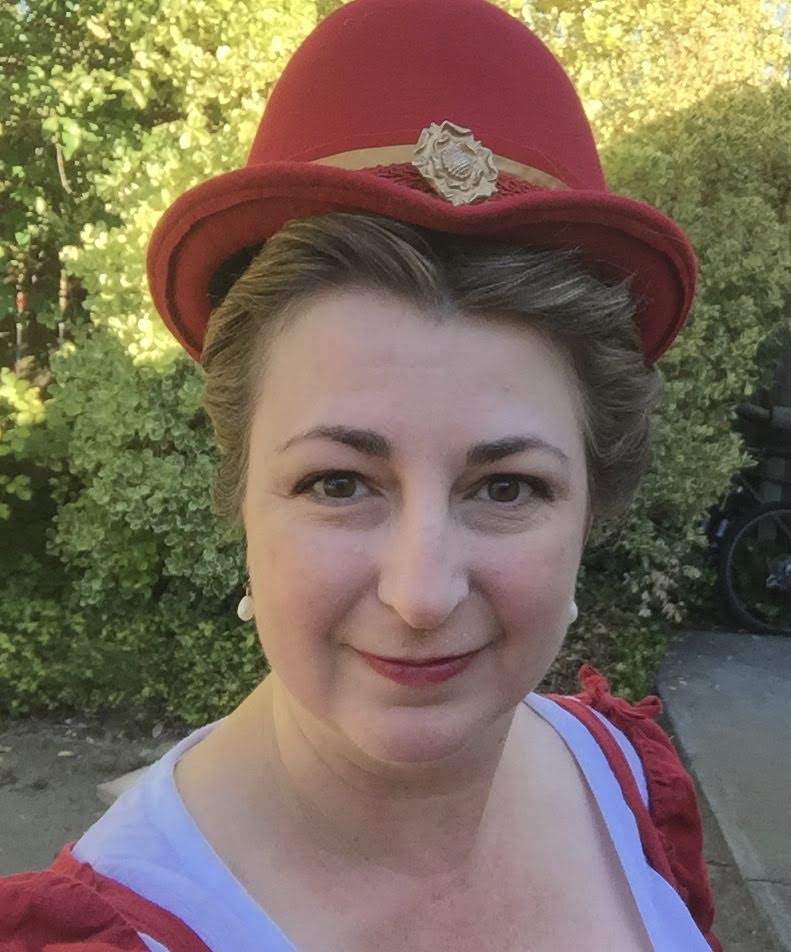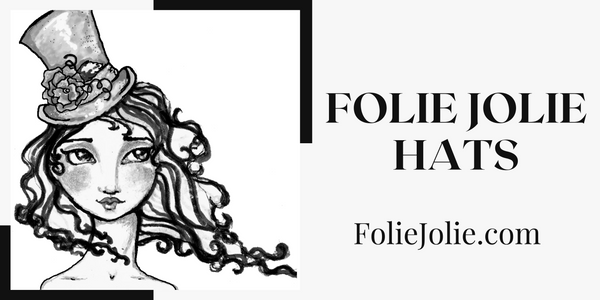
Get Ready With Me: A Milliner's Fair Day Prep!
Share
Well met, gentle patrons! My days at the Renaissance Faire are a delightful whirlwind of blocking hats, meeting fascinating folk, and soaking in all the vibrant atmosphere. But preparing for a long day of selling my one-of-a-kind creations – and, dare I say, doing a bit of immersion theater – is a unique endeavor indeed!
Getting ready as a vendor is a little different than arriving as an attendee. Join me as I share my step-by-step process for transforming from my modern self into your friendly neighborhood Renaissance hat-maker, ready for a grand day of revelry and trade. Let's get ready!
Timing is Everything: It usually takes me anywhere from 30 minutes to an hour to get properly coifed and dressed. And trust me, I much prefer not to do that in my booth while setting up my displays! I typically get ready at home or our hotel before we head to the festival site.
Step 1: Moisturize and Prep Skin
I start with sunblock before I even put on my shift. It's one of the best ways to ensure everything gets covered! I generously apply it to my face, ears, entire neck, shoulders, upper back, décolletage, and upper chest. Oh, and the part in my hair! There's nothing worse than having a shoulder seam shift and ending up with a sunburned strip of skin in a random spot. I use a mineral sunscreen that leaves a bit of a white cast, which, happily, gives a touch of that fashionable Renaissance "lead face" makeup.
Step 2: Hair and Makeup
Hair: I have short hair, so a wig cap is essential to keep everything tame. I part my hair over my crown from ear to ear, then the front section is parted down the middle. I twist the front sections, starting at the center part on each side and twisting back from my face, securing them with plenty of pins. Then, I pin as much of the crown of the back section into a small bun—this gives me a perfect spot to anchor my hats. The shorter back of my hair gets some gel and is bobby-pinned upwards. Next, I apply the mesh wig cap, using U-shaped pins all around to secure the hair from my center crown back. All of that gets covered by a lightweight linen cap, embroidered if I'm feeling particularly fancy that day.
Makeup: With my mineral sunblock base already on, I like to use Little Bits Historic Apothecary's white face paint if I feel like I need a little extra coverage. A tiny bit of liquid blush, and a touch of brown eyeliner to make me look awake, are next. I use the same liquid tint to stain my lips and then coat them with a comfy, moisturizing lip balm. And that's it! I don't usually wear mascara or eyeshadow; they're not really needed for the era (though no harm if you like them!), but my eyes often get irritated, so the fewer products, the happier my eyeballs!
Jewelry: You can put on jewelry now or after dressing. I keep it simple, pearl drop earrings were worn by all genders, a ring or two, and done.
Step 3: Finally, the Clothes!
I'm a gown-wearer, so this is a historically feminine silhouette. Wanna try out feminine pronouns? If you wear this, you'll be "Madamed," "Mistressed," and "M'ladied" to your heart's delight. Not your jam? No worries, there are plenty of other options! Comment if you'd like some masculine get-ready-with-me tips, and I'd be happy to consult my non-binary friends for their best Ren Faire clothing advice. Remember, Ren Faire was created in the counterculture of 1960s California and is rooted in including all folks!
- First, my linen shift and underwear. I also put on some "chub rub" shorts to help keep me cool and prevent chafing.
- Tall socks, stockings, or tights and shoes are next. They're much easier to put on before the rest of the layers.
- A rope-stiffened petticoat goes on. This gives fullness to my skirt and helps keep fabric off my legs in the heat. If I were portraying a higher class or a 17th-century costume, I'd also add a hip roll and possibly a Spanish farthingale, stiffened with reeds. I'm aiming for a ~1580s style.
- I'm blessed with "large tracts of land," so I often wear a pair of bodies for support. This is an early form of stays or a corset and it's historically debatable whether someone of my middle-merchant class would wear it. Mine is made of 100% linen and synthetic whalebone and feels a lot like wearing a longline sports bra: compression, support, and moisture-wicking. Nice!
- Next, the kirtle, or underdress. I'm based in California, and it's hot from May through October, so I wear 100% linen. Wool would be more accurate, and I hear summer-weight wool works in our summers, but I love linen! It's also easy to wash. I sew my own, using Tudor Tailor patterns. This dress uses 12 yards of linen and is quite heavy! It's side-lacing, so I can get in and out of it myself, though it's nice to have help anyway. So, I slither into the dress, careful not to mess up my hair or face, then tighten the lacings.
- Sleeves go on next. Historically, they were pinned on with straight pins, which I have done. You can also make them with ties, hooks and eyes, or buttons—whatever you prefer. I typically use ties. The sleeves get tied to the kirtle shoulders.
- Belt and pouches for money. If it's hot, I'll add a feather fan on a long ribbon. I don't recommend putting everything in the world on your belt! I carry a basket for sunblock, lip balm, bandaids, Tylenol, safety-pins, drinking mugs, water, and my shopping to go in. A belt can get heavy and make your back hurt!
- The overdress goes on next. Yes, it's a lot of layers, but it really completes the 16th-century silhouette. Mine has slits in the side seams so I can tuck my hands in to get warm. Your money will be safe from scallywags and ne'er-do-wells under the overgown! If it's going to be over 90°F or 32°C, I will skip the overgown.
- Hats and accessories are the final step. I wear a coif and usually a tall hat. I pin the tall hat through the coif and anchor it to the little bun on the crown of my head. It's not going anywhere! I've worn this setup in significant winds and retained my hat easily. I also put on my neck and wrist ruffs if I'm wearing them that day; they add some nice sun protection for my neck.
- Then I drape my chatelaine ribbon around my neck. This is a wide ribbon that has my millinery kit attached at the ends: a pincushion with pins, a thimble, small cast-iron scissors, a small thread keeper, and a linen tape measure. I use these a lot at my booth, and it's so helpful to have them close at hand.
And that's it! Since I have a home base at my booth, we stock water and snacks there, so I don't have to carry them around. What are your must-have items for a long day at the faire?
